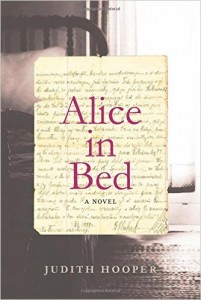 Alice in Bed: A Novel
Alice in Bed: A Novel
by Judith Hooper
Counterpoint Press
322 pages, $25.
ALICE JAMES, the youngest sibling in an eccentric but brilliant family, was as an adult an invalid and a diarist. Her father was a suicidal, one-legged theologian, lecturer, and author of self-published books that no one bought. The family was independently wealthy and traveled often from the U.S. to Europe. Three of her four older brothers suffered bouts of insanity. Alice’s parents paid to keep her two eldest brothers, William and Henry, out of the Civil War. William was educated to be a doctor and Henry a lawyer. Neither followed his educational destiny. William became a celebrated teacher, psychologist, and philosopher who spent most of his life at Harvard, Henry a world-famous novelist who lived in Paris and then England.
Judith Hooper’s Alice in Bed is a fictionalized account of Alice James’ life, and much of the focus is her relationship with William and Henry James, as well as the brothers’ attitudes toward each other. For example, Hooper has William say of Henry’s writing: “There’s something cold, thin blooded and priggish in [Henry’s] stories.” Two other brothers, Bob and Wiley, were not saved from service in the Civil War. Little more than their names and fates is revealed in the family drama. They both married and lived in Wisconsin. Wiley died young, and Bob was in and out of sanitariums most of his life. His madness included terrible mood swings and alcoholic rages.
A major theme of the novel is the role of women in the late 19th century. The situation for unmarried daughters was appalling. Alice’s own Aunt Kate, who lived with the family, had no home of her own and lived with relatives caring for her nieces and nephews, doing whatever was needed. But the situation for married daughters was often worse. They bore and took care of their children and were often virtual slaves to their husbands. Alice James captures this state of affairs in metaphor: “A hoop skirt is a death trap.”
Alice’s first sexual relationship was with a friend, Sara Sedgwick, when both were eighteen. Later, she met Katherine Loring, and the two remained in a committed relationship for many years, through Alice’s breakdown after her father’s death and through all the years in England when she was unable to walk and in chronic pain. Katherine traveled back and forth across the Atlantic to be with Alice, who lived in a small apartment with a hired caregiver. Alice became a recluse, making scrapbooks from newspaper articles and writing a journal that survived her. In the final years she dictated her diary to Katherine.

The two had met when Alice was teaching (1873–76) for a project called “The Society to Encourage Studies at Home,” a correspondence school for women. With access to a good many books, several well-read women, acting as teachers, sent books and assignments to women in the western U.S. and communicated with them via essays and letters. One student confided to Alice that she had to hide the book she was sent, keeping it in the root cellar, away from her husband. The woman claimed that she’d been sold as a mail-order bride by her poor family in Philadelphia to a frightening, alcoholic husband who wouldn’t tolerate his wife being educated.
The novel is constructed in nonlinear movements of time and place. Often time and information can be gleaned from italicized, short letters to and from William, Henry, and Alice. Keeping track of where the scene is in Alice’s life becomes important as the book goes on. We first find her with her friend Sara. Both are eighteen and drinking absinthe, talking about the wonders of life, as Sara gradually seduces Alice. Then we travel back even further, to her thirteenth birthday, when she had the first episode of “going off,” by which she meant a loss of consciousness, possibly a fainting spell.
Alice suffered from fainting spells and headaches, for which she endured a myriad of treatments. Her ailments were diagnosed as suppressed gout, wandering womb, and several other 19th-century maladies. In an afterword, Hooper attempts to explain what may have been Alice’s real diagnosis by considering her symptoms. It could have been benign paroxysmal positional vertigo, an inner ear infection, or anxiety.
Alice in Bed is well-written and detailed enough to place the reader into each scene with the cast of characters. Admittedly the Jameses knew many of the intellectuals of their time, but Judith Hooper throws in some unlikely celebs to have crossed paths with family members, from Freud and Flaubert to Emile Zola and Annie Oakley. Even Gertrude Stein and her brother Leo drop by for dinner. The novel form that gives Hooper license to elevate the Jameses’ social standing also makes possible the intimate scenes between Alice and Sara or Alice and Katherine that the author provides.
Martha Miller is a Midwestern writer whose recent books include Nine Nights on a Windy Tree and Widow: A Bertha Brannon Mystery.





